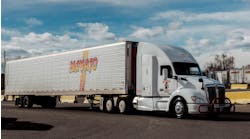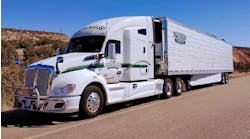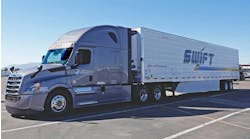Halvor Lines Inc focuses on key factors for driver, customer satisfaction
FOR seven consecutive years Halvor Lines Inc has been rated in the CarriersEdge/Truckload Carriers Association program as one of the Best Fleets To Drive For. Management sees that as a critical achievement.
Put simply, they believe satisfied drivers help build satisfied customers. To keep drivers happy, the carrier provides them with late model tractors spec’d with the latest safety technology, keeps them busy, and provides them with the on-going training they need to operate safely and efficiently.
“We have a strong people culture at Halvor Lines,” says Carl Svendsen, chief strategy officer at Halvor Lines. “We go to great lengths to take care of our people. Satisfied workers are more productive and are more willing to go above and beyond to serve our customers. We provide our company drivers with newer tractors that are spec’d for safety and reliability. The average age for our company tractor fleet is 25 months. The average for our trailer fleet is around four years.
“Customer service is what sets us apart from other carriers. Many of our customers have been with us for more than 15 years, and some have been with us for over 30 years.”
Founding friends
The focus on people and customer service started early, dating back to when Halvor Lines was founded in 1968 by Bill Vinje and four owner-operator friends who began hauling snowmobiles and miniature Christmas trees across the United States and Canada. The company they initially contracted with—Duluth, Minnesota-based Halvorson Equipment—became the inspiration for the name Halvor Lines.
Bill eventually bought out the other owners and became Halvor’s chief executive officer. By 2001, Halvor Lines had grown from five trucks to 200 thanks to Bill’s focus on safety, dependability and respect for his customers, drivers and office staff.
Halvor continues to grow under the leadership of Bill’s son and chief executive officer Jon Vinje, his grandson and president Ryan Fraley, and other family members. Today, they lead a team of more than 725 employees, company drivers, and owner operators who support operations in 49 US states and Canada. Their fleet of roughly 550 tractors and 1,500 trailers are dispatched out of four midwestern terminals in Rosemount, Minnesota; Superior, Wisconsin; Des Moines, Iowa; and South Bend, Indiana.
For the past decade, Halvor has offered enhanced transportation and trucking services through its partnership with Halvor Logistics. Together, Halvor Lines and Halvor Logistics offer the power of more than 4,500 carrier partners and the ability to deliver goods anywhere in the United States and Canada.
Customer diversity
The carrier serves an increasingly diverse customer base with a wide range of trailers. In addition to 185 refrigerated trailers, the fleet includes dry vans, step decks, flatbeds, and conestogas.
“We have had refrigerated transport operations from the beginning and have steadily expanded that side of the business,” Svendsen says. “The biggest growth came after the acquisition of another fleet in 2015. We doubled the size of the refrigerated fleet since then. We’re adding more reefer trailers to expand the amount of drop-and-hook activity.
“Refrigerated transport is a great business, because people always have to eat. The volume of loads is consistent. The cargo range includes poultry, pork, fish, and cheese. We also have quite a few temperature-controlled shipments, such as wine, liquor, beer, and non-hazardous chemicals.”
While some of the other Halvor Lines operations include Canada, all of the refrigerated transport activity is in the United States. Operations are heaviest east of the Mississippi River, and the average length of haul is 1,150 miles.
Refrigerated fleet drivers typically spend eight to 10 days at a time on the road. “When it comes to time on the road, we take driver preference into consideration,” says Buck Hammann, Halvor Lines chief operating officer. “We try to accommodate drivers as much as possible.
“Those with a desire can spend more time on the road. We can also move our drivers around our system to give them the opportunity to drive in the highest performing divisions. We do a lot of that in our ‘Race to the Finish’ program in the fourth quarter. They have an opportunity to earn up to $1,000 in additional pay in the last quarter.”
A liberal rider policy contributes to greater driver satisfaction and retention. Halvor Lines allows drivers to be accompanied by spouses, children, and even pets.
Central dispatch
To ensure that the fleet keeps moving smoothly and efficiently, fleet operations are directed by central dispatch in the headquarters terminal in Superior, Wisconsin. The carrier uses TMW Suite for dispatch and other management functions.
“For more than three years, we’ve been using Power BI reporting software that enables us to manipulate data throughout our system,” says Bonnie Ramsay, Halvor Lines chief information officer. “We also provide customers with the ability to monitor load status throughout the transport process. Access is password protected.
“We’re paying close attention to cybersecurity. Attacks such as ransomware are a serious concern, and we do our best to mitigate the threats. Besides limiting access, we protect our system with a robust firewall. We also perform regular penetration testing on the network.”
Dispatchers communicate with drivers through tablet computers. Drivers can choose any tablet with AT&T or Verizon cell phone service. Apps used on the tablets include Sign Easy signature capture.
For electronic driver logs, Halvor Lines chose the TransFlo app with Geotab satellite tracking. Ramsay says the carrier chose the TransFlo system because they believed that was the only product that was fully compliant with the Department of Transportation’s electronic Logging device (ELD) rule when the carrier switched to ELD’s in March 2019. Halvor Lines has been running electronic driver logs since 2010.
Fleet technology
Technology plays a critical role in helping drivers operate safely and efficiently, according to Adam Lang, Halvor Lines chief risk officer. ELDs are just the tip of the tech iceberg.
“This company invests a lot of money in safety technology, and we look for drivers who share our passion for safety,” Lang says. “Our goal is to steadily reduce and eventually eliminate all accidents. We work hard to minimize loss for this company and its employees. It strengthens the bottom line, and it’s the right thing to do. It’s a long-time commitment that comes from the top down.”
The search for the right drivers has given the carrier a team that includes 25% to 30% military veterans. Slightly more than 8% are female drivers.
“We believe the right attitude is more important than age or experience,” Lang says. “We want safe drivers who want to build a long career with us. We’ll take a driver fresh from truck driving school and put him or her through a five-week finishing program.”
Driver candidates fill out an online application through the Tenstreet portal. They must have a valid commercial driver’s license and must be able to pass driving and criminal background checks.
Those selected are scheduled for a 3½-day orientation at the headquarters terminal in Superior. Training and testing include a drug test, road test, written test on rules of the road and signage, and a physical agility screening. Training includes time in the carrier’s computerized driving simulator.
Average class size is six to 10 drivers, with some classes containing up to 12.
During their time at the orientation, drivers meet some of the 50 driver trainers in place across the Halvor Lines system. They also learn that training is an ongoing process. “We assign a lot of homework that employs CarriersEdge training modules,” Lang says.
The carrier requires successful completion of one module of training each quarter. Each on-line training session takes 1½ to three hours.
Drivers also have to participate in Smith System training sessions that are given every week on Friday at the Superior terminal. One quarterly class also is offered at the Rosemount terminal.
To help reinforce the safety focus and strengthen the driver relationship, the carrier recently formed a nine-person driver advisory board. Members of the board—all of them company drivers—provide a broad perspective with a wide range of backgrounds and ages. Three members are women.
“We just started the board this year, and we are already getting some great ideas from the members,” Lang says.
The carrier also established a Million Mile Club for drivers in 2016. Already, 137 drivers have been recognized in four mileage categories ranging from 1 million to 4 million miles of accident-free driving.
Safety tech
Some of the latest trucking technology helps drivers avoid accidents and protect the motoring public. Key systems include collision avoidance technology and event recorders. Air disc brakes and roll stability systems are spec’d on all new tractors and trailers.
“We’ve seen a big reduction in rear-end accidents since adding the collision avoidance technology,” Lang says. “In addition, virtually all rollovers have been eliminated with the roll stability systems.”
The newest Volvo VNL-760 tractors are equipped with Bendix Wingman Fusion collision avoidance and roll stability, Netradyne’s camera system (forward through the windshield and rearward facing on the side mirrors), and Meritor air disc brakes.
All are 72-inch sleeper units with EpicVue television receiver and a DirectTV subscription that is paid for by the carrier. The sleeper also comes with a refrigerator, power inverter, and an Espar heater.
The tractor powertrain includes a Volvo D13 engine rated for 455 horsepower and I-Shift automated transmission. Michelin duals are preferred for the drive positions, and the tires are mounted on Alcoa aluminum wheels.
Tractor fuel tanks are fitted with Arctic Fox heaters. “Those fuel tank heaters do a great job of keeping our trucks running in extreme cold,” Hammann says. “We also have less need for fuel blending during the winter.”
Reefer trailers
In addition to 50 new refrigerated trailers purchased in 2019, Halvor Lines will add 40 more in the January/February timeframe. All of the reefer trailers are from Utility and all are 53 feet long.
Carrier Transicold’s X4 7500 refrigeration unit is the standard unit on the trucking company’s newest trailers. Generating up to 68,000 Btu of cooling, the refrigeration unit can easily maintain temperatures down to -20 F.
Reefer units are equipped with the Blue Tree telematics system that transmits GPS position, refrigeration temperature, security alerts, and fuel level. In addition, it gives administration personnel the ability to adjust refrigeration unit settings.
Helping to maintain the coldest settings, the trailers have 4 inches of foam insulation all around. Trailers are lined with fiberglass-reinforced plastic panels. Floors are corrugated aluminum. Running gear includes Hendrickson’s Vantraax suspension and axle system. Trailer side skirts are delivering up to 8% in fuel savings.
Fleet maintenance
Most of the tractor and trailer maintenance is handled in-house at the carrier’s shops in Superior, Rosemount, and South Bend. Tractors are on a 25,000-mile preventive maintenance schedule with a safety inspection and lube at each 25,000-mile mark, with an oil and filter change at 50,000-mile intervals.
“We do all refrigerated trailer work in-house,” says Jeremy St Pierre, Halvor Lines director of maintenance. “We want to see reefer trailers in one of our shops every 90 days for a PM check.”
In addition to vehicle maintenance, the Halvor Lines maintenance team is paying closer attention to reefer trailer cleanliness. “We try to do as much vehicle washing as we can in-house, but we do use commercial wash facilities, such as one location adjacent to our Superior terminal and numerous Blue Beacon locations across the United States,” St Pierre says.
Every step taken in the Halvor Lines operation is designed to ensure that the trucking company provides its driver team the safest and most comfortable work environment and the best possible service to customers. Nothing is left to chance.


